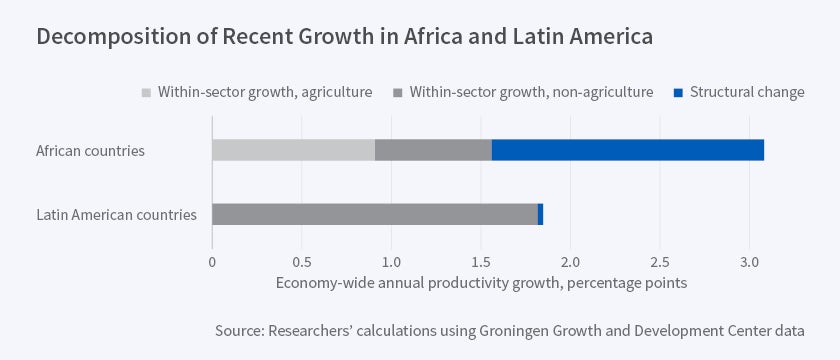Exploring Pathways to Economic Development
Developing countries in Latin America and Africa have not followed the rapid, export-oriented industrialization strategy that was used in East Asia.
Many countries in the developing world have experienced a remarkable period of economic development over the last several decades. Besides India and China, which registered record growth rates, countries in sub-Saharan Africa and Latin America have managed to match or exceed their performance of the 1960s and first half of the 1970s.
Even a cursory look at the recent growth champions indicates that their experience differs greatly from the standard East Asian path. East Asian countries such as South Korea, Taiwan, and China grew through rapid, export-oriented industrialization. By contrast, none of the recent growth experiences outside East Asia show evidence of rapid industrialization. Instead, Latin American countries have experienced premature deindustrialization, while in Africa manufacturing industries are barely holding their own in most countries.
What then is driving economic growth in these countries and how sustainable is this growth? In The Recent Growth Boom in Developing Economies: A Structural Change Perspective (NBER Working Paper 23132), Xinshen Diao, Margaret McMillan, and Dani Rodrik offer a structuralist perspective on this experience, focusing on the role of structural change in driving economy-wide labor productivity growth. In East Asian countries, the movement of labor from low-productivity agriculture to modern manufacturing industries and associated activities played a critical role. The researchers ask whether there was a similar transformation in the recent crop of growth accelerations, and whether the expansion of other modern activities, such as services, played the role that industrialization played in East Asia. They examine the relationship between patterns of structural change and labor productivity growth within specific industries, focusing on country-specific growth accelerations that started as early as 1988 and as late as 2003, and lasted for at least seven years.
Contrary to the experience in East Asia, these recent growth accelerations were based on either rapid within-sector labor productivity growth, which was the typical pattern in Latin America, or growth-increasing structural change, the typical pattern in Africa, but rarely both at the same time. In fact, there is a strong negative correlation between the two components of growth across countries, with India as the sole exception. In Latin America, within-sector labor productivity growth has been impressive, but growth-promoting structural change has been very weak. The researchers report that, excluding agriculture, structural change has made a negative contribution to overall growth, meaning labor has moved from high-productivity sectors to low-productivity activities. By contrast, the situation in Africa is the mirror image of the Latin American case. Growth-promoting structural change has been significant, especially in Ethiopia, Malawi, Senegal, and Tanzania, but has been accompanied in these countries by negative labor productivity growth within non-agricultural sectors such as manufacturing and services. This experience stands in sharp contrast to the classic East Asian growth experience in South Korea and China, in which both components of labor productivity contributed strongly to overall growth. Moreover, the East Asian pattern also seems to have been replicated in more recent Asian growth accelerations, such as those in Bangladesh, Cambodia, Laos, Vietnam, and India.
The researchers find that the pattern in East Asia of strong productivity growth within individual sectors, as well as a shift of economic activity across sectors toward more productive ones, is consistent with growth being driven mainly by positive productivity shocks to the modern sectors. The African model, by contrast, is consistent with growth being driven not by the modern sector, but by positive aggregate demand shocks due to foreign transfers, for example, or productivity growth in traditional agriculture.
These patterns suggest that positive structural change in African countries may be driven mainly from the demand side, the researchers conclude, whether due to external transfers or induced demand effects from increased agricultural incomes. This in turn raises the issue of the sustainability of recent growth in Africa and highlights the importance of productivity-enhancing public investments in areas such as education, health, and infrastructure.



